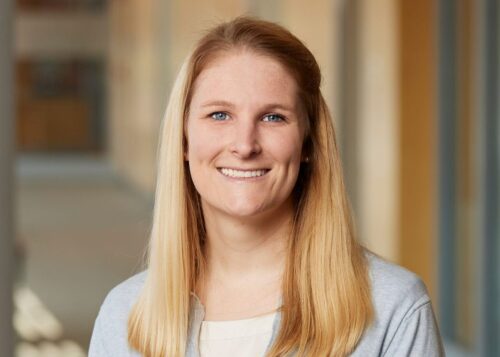
Adam Knee
To quell a rising epidemic, BMC has embedded HIV counselors in the ED to increase declining testing rates and connect people to effective treatment.
While COVID-19 continues to make public health headlines, a quieter but concerning epidemic is growing in Boston. A rising cluster of new HIV infections in the city is worrying health officials. Since early 2019, 113 HIV cases have been diagnosed in the Boston area, with 13 newly identified cases since January 2021. Boston Medical Center (BMC) experts believe the outbreak’s scope may be more extensive. Still, with much of ambulatory care suspended during the height of the COVID-19 pandemic, HIV testing rates at the hospital plummeted by more than 90%.
To quell the rise in cases, the Massachusetts Department of Public Health (DPH) is funding new public health initiatives in Suffolk County to prevent, diagnose, and treat HIV. At BMC, the DPH funds will support HIV counselors embedded in the emergency department to educate, test, and counsel patients receiving care. It is an intervention that makes sense—the majority of the new HIV infections are among people who use intravenous substances and people experiencing homelessness, says Elissa Schechter-Perkins, MD, MPH, director of emergency medicine infectious disease management.
“The emergency department is an excellent place for public health initiatives such as HIV and hepatitis C testing and counseling as the department acts as an interface between the hospital and the community and is often the only place where the most at-risk members of the community seek their care,” explains Perkins.
What do HIV counselors in the emergency department do?
Since June, the new HIV counselors have been in BMC’s emergency department to better engage and educate patients on HIV prevention, including discussing prescriptions for pre-exposure prophylaxis (PrEP) for those at risk of contracting HIV and the importance of knowing your HIV status to connect to early treatment. Counselors offer both standard HIV laboratory testing and the rapid antibody screening test, which provides a patient who cannot be easily contacted results in 30 minutes.
Testing and counseling at this level is time-consuming work that emergency department staff are often unable to commit to when treating the acute needs of patients.
“HIV testing in the emergency department has not been commonplace whatsoever. Testing is usually encountered when someone has specific symptoms and is about to be admitted,” Cassandra Pierre, MD, MPH, medical director of BMC public health programs and acting hospital epidemiologist, explains. “Otherwise HIV tests are often considered routine, preventive tests that occur in primary care where providers can follow up with patients after a positive result.”
New national data published in the May issue of the Annals of Emergency Medicine confirms Pierre’s statement. The new study by Simeon Kimmel, MD, et al. utilized nationally representative data from the National Hospital Ambulatory Care Survey to estimate trends and factors associated with HIV testing in the emergency department. Kimmel—who is the medical director of BMC’s Project TRUST, a harm reduction-focused drop-in center—found that individuals with substance use disorders were more likely to receive an HIV test in the emergency department than those without SUDs. Yet still, between 2014 and 2018, only 1.4% of emergency department visits for those with SUDs resulted in an HIV test.
The data show despite recommendations for universal opt-out HIV testing in emergency departments and increased risk of HIV among people using drugs, HIV testing in emergency departments is rare among people who use substances.
A vision for increased HIV testing and treatment in the ED
The authors argue new efforts are needed to increase HIV testing in emergency departments, especially among people who use intravenous drugs.
With alarming clusters of HIV among people with SUDs continuing to pop up in some regions of the U.S., more robust testing within emergency departments could help experts gain a more complete picture of the rate of infection in the U.S. population and stop further transmission by connecting newly HIV-positive patients to early treatment.
Once-a-day treatment with an antiretroviral can drastically reduce viral load and eliminate the spread of the virus by infected individuals.
Despite the many barriers caused by intravenous drug use and homelessness that are common risk factors, people in treatment have shown encouraging adherence rates to taking HIV medications. Of the 1,300 patients currently treated for HIV in BMC’s Infectious Diseases clinic, 96% take antiretrovirals, and 92% have undetectable levels of virus thanks to adherence to medication.
“Regardless of the barriers they face, our patients are amazing. They’re resilient. They can find a way to take their medication and the joy is in helping them identify the ways that they can become adherent,” says Glory Ruiz, director of BMC public health programs.
Embedding culturally competent HIV counselors is an investment that BMC experts believe can further instill trust and provide continuity of care, furthering access to addiction treatment, mental health care and primary care for an extremely underserved population while also helping to stop the spread of infections in the city. For ED Prevention Team Coordinator Ovianna Pena, who serves as one of the new HIV counselors, it is crucial outreach that builds one patient at a time.
“I had a patient recently who was very angry. None of the nurses could engage him. He did not want to get tested. I brought him a blanket and some ginger ale. Then I started speaking to him in Spanish, and he opened up. He asked me for a card so that he could also refer his son. I was able to test him,” Pena says. “It takes just one person to get the word around that we really care for the patient, not that we just look at them as a number.”


